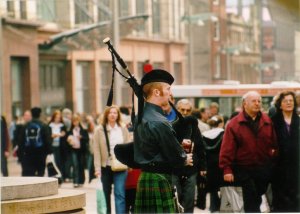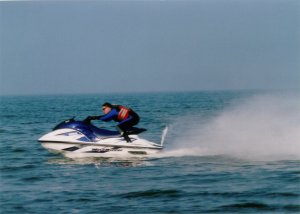
This technique is very useful in portraits and macro photography, because the main subject gets maximum attention from the viewer.
Lens: An optic device through which light enters the camera.
Single Lens Reflex (SLR) camera: A camera where the same lens is used to see and
photograph an image. In all other cameras, the viewfinder lens is different from the
photographing lens, hence the actual picture frame may be slightly different from what the
photographer sees.
SLR cameras also have lens changing facility, and much superior
picture quality.
Aperture: A small hole near the back of the lens. It's opened when the camera user clicks the shutter release button. Its opening action causes light to fall on the film.
Depth of Field: This value decides how much part of the picture will remain
sharply focused. Depth of field depends on the size of aperture. Bigger the aperture,
smaller is the depth of field (less part of picture in focus) and vice versa.

|
This photograph of a bagpiper on the streets of Glasgow, UK, is a
perfect example of small depth of field. Look how the background is
blurred, while only the main subject (bagpiper) is in sharp focus.
This technique is very useful in portraits and macro photography, because the main subject gets maximum attention from the viewer. |
Exposure: Amount of light falling on the film, when a picture is being taken. To know more about exposure, click here
Shutter speed: The speed with which the aperture opens and closes while capturing a
photograph. More the shutter speed, less is the time for aperture to remain open, and vice
versa.
|
Faster shutter speeds are used to "freeze" the action in pictures.
This photograph of a speed boat shows the freezing action.
When the shutter speed is kept high, there's very little time for light to fall on the film. Therefore some compensation has to be done by increasing the size of aperture and thus reducing the Depth of field |

|
Red eye reduction: When a photograph is captured in low light situations, many times the final photograph shows the eyes of people in red color. This is called Red eye effect. This is caused by the light of flash reflecting from the blood vessels in the eyes of subjects. To reduce this effect, many cameras provide an additional lamp below the flash. Just before the flash fires, this lamp fires several times, causing the pupils in the eyes of the subjects to adjust to the light and become small. When the flash fires, the pupils do not dialate, because they are already used to the light. This causes the red eye effect to be minimised, but it may not be wiped out entirely.
Film speed: Film speed indicates the sensitivity of a film to the light. More the speed, more is the sensetivity. E.g. a film with sensetivity of ISO400 will have 4 times more light sensitivity than a film with speed of ISO100. That means an ISO100 film with an exposure of 4 seconds should produce the same results as the ISO400 film with 1 second exposure. But in practice, as the sensetivity increases, the photographs become grainier, because the additional sensetivity comes at a price of reduced resolution.
Modern digital cameras allow the user to change the ISO settings, allowing more flexibility for the varying light conditions. Typically, for brightly lit scenes, ISO100 is ideal. ISO400 is good for indoor scenes, while ISO800/ISO1600 is used for very poorly lit scenes, or when the photographer needs an extremely 'grainy' effect in the snap.
Camera zoom (Optical zoom): It refers to how much the camera can focus on a distant subject. In other words, a larger zoom allows the photographer to capture a far off subject without moving closer, while a smaller zoom allows the photographer to capture a large section of the visible landscape.
In film cameras, the zoom is typically measured in terms of mm (focal length). The lenses sold with the camera normally have values like 28-55 mm, 35-80 mm etc.
In digital cameras, zoom is measured in terms of X (how many times a subject can be magnified). Most of the point-and-shoot cameras have 3X zoom.
A lens with a smaller zoom is called 'wide angle lens', while one with a large zoom is called 'telephoto lens'. Each has its own pros and cons.
A wide angle lens is useful in capturing large landscapes, buildings etc. A telephoto lens is used to capture subjects which are not easy to reach, e.g. wildlife. A telephoto lens may also be used if the subject demands a tighter composition, eliminating all clutter from picture.
Using a telephoto lens also has the effect of producing larger apertures causing a shallow depth of field.
Digital zoom: If the optical zoom provided on the camera is insufficient to close in on the subject, the photographer can make use of 'digital zoom' facility. Digital zoom enables the photographer to expand the zoom capability of the camera at the price of the picture quality.
Using digital zoom eliminates the border pixels in an image, and splits the middle area pizels in such a way that they fill out the entire frame. It results in distorting the picture. So digital zoom should be used sparingly.
PictBridge: A technology used by many modern photo printers to directly print the photos off the camera, without using a computer. A PictBridge compatible camera can directly be connected to a PictBridge compatible printer. Printing can be controlled via camera menus.
Memory card: Please see the Memory Cards page.
Back to Photography Basics Back to Photography Back to the Home page